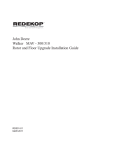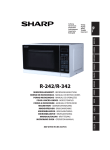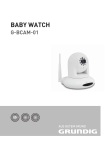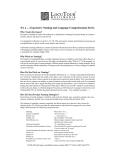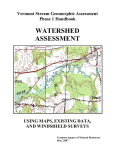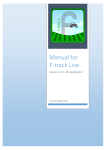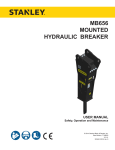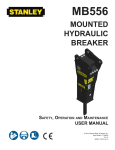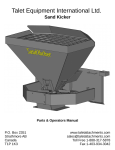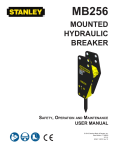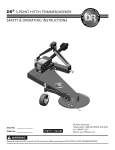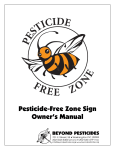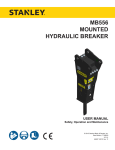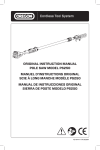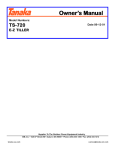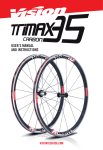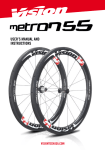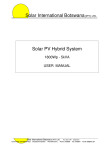Download User`s Manual - Oklahoma State University
Transcript
The Vassar Company’s Soil Conditioner Model 6M • General Information • Trouble Shooting • Specifications Operator’s Manual Table of Contents Specifications...................................................................................................................... 2 Owner Assistance............................................................................................................... 3 General Information.......................................................................................................... 3 Safety Rules......................................................................................................................... 4 Safety Decals....................................................................................................................... 7 Operation............................................................................................................................ 8 Trouble Shooting.............................................................................................................. 13 Maintenance...................................................................................................................... 14 Specifications Raking Width............................................................................................................................................................ 72 Inches Roller Type.............................................................................................................. Tooth Roller Standard 10.5” Diameter Roller Angle.............................................................................................................................. 30 Degrees-Both Directions Weight.......................................................................................................................................................................... 870 Lbs. 2 Owner Assistance Thank you for your purchase of a Vassar Equipment product. We at Vassar hope you are fully satisfied and happy with this piece of machinery and it satisfies all of your needs. If there are any questions you may have, please contact the dealer you purchased the equipment from. If you did not purchase your Soil Conditioner from a licensed Vassar dealer, please contact the one nearest you for parts assistance or customer service. The Vassar Company 1009 West Knipe Avenue Perkins, OK 74059-3860 (405) 547-2454 General Information The purpose of this owner’s manual is to educate and inform you about your machine. It also provides information on maintenance and care of the Soil Conditioner. If performed correctly, this machine will help assist you in all of your landscaping and construction needs with ease. These instructions have been compiled by the senior design team at Oklahoma State University. The data collected and experience has come from engineers and communication and business professionals. Illustrations and drawings in this manual were current at time of printing. Models and designs may have changed from time of printing to your purchase. We reserve the right to redesign and change without consent or notification. 3 Safety Rules Safety is a primary concern in the design and manufacture of our products. Unfortunately, our efforts to provide safe equipment can be wiped out by a single careless act of an operator. In addition to the design and configuration of equipment, hazard control and accident prevention are dependant upon the awareness, concern, prudence, and proper training of personnel involved in the operation, transport, maintenance, and storage of equipment. The design and tested safety of this equipment depends on it being operated within the limitations as explained in this manual. Training • Safety instructions are important. Read all attachment and power units manuals; follow all safety decal information. Failure to follow instructions may result in serious injury or even death • If you do not understand any part of this manual and need assistance, see your dealer. • Know your controls and how to stop engine and attachment quickly in an emergency. • Operators must be instructed in and be capable of the safe operation of the equipment, its attachments and all its controls. Do not allow anyone to operate this equipment without the proper instructions Attention: Become Alert. Your Safety is Involved Awareness • Keep hands and body away from pressured lines. Use paper or cardboard, not body parts, to check for leaks. Wear safety goggles. • Hydraulic fluid under pressure can easily pen- etrate skin and will cause serious injury or death. • Make sure that all operating and service personnel know that in the event hydraulic fluid penetrates skin, it must be surgically removed as soon as possible by a doctor familiar with this form of injury, or gangrene, serious injury or death will result. CONTACT A PHYSICIAN IMMEDIATELY IF FLUID ENTERS SKIN OR EYES. DO NOT DELAY. • Do not allow children or untrained persons to operate equipment. Preparation • Always check with your skid-steer manual or dealer for counter weight ballast that may require for machine stability. • Air in hydraulic systems can cause erratic operation and allows loads or equipment components to drop unexpectedly. Before operating or allowing anyone to approach the equipment, purge any air in the system by operating all hydraulic functions several times after connecting equipment, connecting hoses, or doing any hydraulic maintenance. • After connecting hydraulic hoses, check that all control lever positions function as instructed in the operator’s manual. Do not operate until control lever and equipment movements are correct. • Make sure all hydraulic hoses, fittings, and valves are in good condition and not leaking before starting power unit or using equipment. Check and route hoses carefully to prevent damage. Hoses must not be twisted, bent sharply, kinked, frayed, pinched, or come into contact 4 Safety Rules with any moving parts. Operate moveable components through full operational range to check clearances. Replace any damaged hoses immediately. • Always wear relatively tight and belted clothing to avoid entanglement in moving parts. Wear sturdy, rough-soled work shoes and protective equipment for eyes, hair, hands, hearing and head. • Ensure implement is properly attached, adjusted and in good operating condition. Operational Safety Improper operation can cause the machine to tip or roll over and cause injury or death. • Keep skid-steer lift arms and attachment as low as possible • Do not travel or turn with skid-steer lift arms and attachment raised • Turn on level ground • Go up and down slopes, not across them • Keep the heavy end of the machine uphill • Do not overload the machine Never use the skid-steer attachment to carry loads that exceed skid-steer rated operating capacity or other skid-steer specifications. Check your skidsteer manual or with your dealer for skid-steer rated operating capacity. Exceeding this capacity can cause machine to tip or roll over and cause injury or death. • Use of a front safety door on the skid-steer is recommended for operation of the Vassar Soil Conditioner. • Do not allow other people in the area when operating, attaching, removing, and assembling or servicing equipment. • Only engage power when equipment is at ground operating level. Always disengage power when equipment is raised off the ground. • Do not disconnect hydraulic lines until all system pressure is relieved. Lower unit to ground, stop engine, and operate all hydraulic control levers. • Keep bystanders away from equipment while it is in operation. Never go underneath equipment lowered to the ground or raised. Never place any part of the body underneath equipment or between moveable parts even when the engine has been turned off. Hydraulic system leak down, hydraulic system failures, mechanical failures or movement of control levers can cause severe injury or death. • Service work does not require going underneath the attachment. • Read operator’s manual for service instructions or have done by a qualified dealer. • Never direct discharge toward people, animals or property. • Do not operate equipment while under the influence of alcohol or drugs. • Operate only in the day light or good, artificial light. • Keep hands, feet, hair and clothing away from equipment while engine is running. Stay clear of all moving parts. • Always comply with all state and local lighting and marking requirements. • Do not allow riders. Do not lift or carry anybody on the skid-steer or attachments. • Always sit in skid-steer seat when operating controls or starting engine. Securely fasten seat belt/operator restraint, place transmission in park or neutral, engage break and ensure all other controls are disengaged before starting skid-steer engine. Safety Rules • Look down and to the rear and make sure area is clear before operating in reverse. • Use extreme care when working close to fences, ditches, other obstructions, or on hillsides. • Do not operate on steep slopes. • Do not stop, start, or change directions suddenly on slopes. • Use extreme care and reduce ground speed on slopes and rough terrain. • Watch for hidden hazards on the terrain during operation. • Stop skid-steer and implement immediately upon striking obstruction. Dismount skid-steer using proper procedure. Inspect and repair and damage before resuming operation. • Before leaving skid-steer steer operator’s seat, follow skid-steer manual instructions. Lower skid-steer lift arms and put attachment on the ground. Stop engine, remove key, brake and remove seat belt/operator restraint. Maintenance Safety gine running. • Keep all persons away from operator control area while performing adjustments, service or maintenance. • Tighten all bolts, nuts, screws and check that all cotter pins are installed securely to ensure equipment is in safe condition before operating. • Ensure all safety decals are installed. Replace if damaged. • Ensure shields and guards are properly installed and in good condition. Storage • Follow manual for storage. • Keep children and bystanders away from storage area. Notes Your dealer can supply original equipment hydraulic accessories and repair parts. Substitute parts may not meet original equipment specifications and may be dangerous. • Avoid electrical system hazards. Never work on the electrical system unless you are qualified and thoroughly familiar with system details and the special handling requirements. Disconnect battery before working on electrical system. Remove “ground” cable first. When reconnecting battery, connect “ground” cable last. • Ensure implement is properly attached, adjusted and in good operating condition. Skidsteer coupler lock pins must be fully extended and properly engaged into attachment retaining slots. Never perform service or maintenance with en6 Safety Decals !WARNING! Do not allow anyone to operate the Soil Conditioner or skid-steer who has nor been properly trained in it’s safe operation and has not read and understood the operator’s manuals. Before attaching implement, check skid-steer loader lift capacity to ensure its ability to safely handle the weight. Do not operate without guards/shields in place and in good working order. Stop all moving parts including skid-steer engine before cleaning, unplugging, adjusting and/or performing maintenance. Keep bystanders at least 10 feet away from the Soil Conditioner when in operation. Failure to follow the above safety suggestions and those in the operator’s manual can result in serious injury or death. Operation Safety is a primary concern in the design and manufacture of our products. Unfortunately, our efforts to provide safe equipment can be wiped out by a single careless act of an operator. In addition to the design and configuration of equipment, hazard control and accident prevention are dependent upon the awareness, concern, prudence, and proper training of personnel involved in the operation, transport, maintenance, and storage of equipment. It has been said, “The best safety device is an informed, careful operator.” We ask you to be that kind of an operator. The operator is responsible for the safe operation of this equipment. Operators must be instructed in and be capable of the safe operation of the equipment, its attachments, and all controls. Do not allow anyone to operate this equipment without proper instructions. The 6M Vassar Soil Conditioner is designed for removing rock and small debris, and for thatching. Skid-steers must be equipped with an auxiliary hydraulic system capable of supplying continuous flow for hydraulic motor operation. This manual contains information for the 6M angling model. Refer to the information in this manual for specifications, parts, assemblies, and adjustments. WARNING • Safety instructions are important! Read all attachment and power unit manuals; follow all safety rules and safety decal information. Failure to follow instructions or safety rules can result in serious injury or death. • Do not allow children or untrained persons to operate equipment. • Skid-steer must be equipped with ROPS and seat belt/operator restraint. Keep seat belt/operator restraint securely fastened/engaged. Falling off skid-steer can result in death from being run over or crushed. Keep ROPS systems in place at all times. • Do not allow other people in the area when operating, attaching, removing, assembling, or servicing equipment. • Never go underneath equipment lowered to the ground or raised. Never place any part of the body underneath equipment or between moveable parts even when the engine has been turned off. Hydraulic system leak down, hydraulic system failures, mechanical failures, or movement of control levers can cause equipment to drop or rotate unexpectedly and cause severe injury or death. • Service work does not require going underneath. • Read Operator’s Manual for service instructions or have done by a qualified dealer. • Before leaving skid-steer operator’s seat, follow skid-steer manual instructions. Lower skid-steer lift arms and put attachment on the ground. Stop engine, remove key, engage brake, and remove seat belt/operator restraint. ATTACHING POWER RAKE TO SKID-STEER • Read the skid-steer Operator’s Manual connecting and removing instruction. • Position hydraulic hoses so they will not be pinched when connecting the power rake. • Move to the skid-steer operator seat and start engine. • Lower skid-steer lift arms to their lowest position. • Carefully move and align the skid-steer to the power rake. The top of the skid-steer coupler must index into the power rake flange. 8 Operation • Roll the skid-steer coupler into the power rake so the coupler handles can be engaged. • Shut off the engine, set brake, and remove key. Dismount the skid-steer. • Move the skid-steer coupler handles to the locked position. The lock pins must be completely extended and secured into the slots provided on the power rake. • Connect hydraulic hoses to skid-steer auxiliary quick couplers. • For hydraulic angling models, mount the angle control switch in a convenient, easy-to-reach location. The switch bracket is magnetic and will attach to any flat steel surface. Connect the power cord to the cable coming from the switch. Be careful when routing the cable that sharp edges or moving parts will not damage the cable. POWER RAKE FUNCTION • The power rake hydraulic motor drives the roller, which digs into the ground, cultivating and pulling up rocks, roots, and debris. • The clean soil goes between the roller and barrier, while the rocks, roots, and debris work to the side in a windrow. PRE-OPERATION CHECK LIST (OWNER’S RESPONSIBILITY) • Review and follow all safety rules and safety decal instructions on page 7. • Check that all safety decals are installed and in good condition. Replace if damaged. • Check that all shields and guards are properly installed and in good condition. Replace if damaged. • Check that all hardware and cotter pins are properly installed and secured. • Check that equipment is properly and securely attached to skid-steer. • Do not allow riders. • Check and keep all bystanders away from equipment working area. • Check and grease both bearings as instructed in the maintenance section. • Check that all hydraulic hoses and fittings are in good condition and not leaking before starting skid-steer. Check that hoses are not twisted, bent sharply, kinked, frayed, or pulled tight. Replace any damaged hoses immediately. OPERATING INSTRUCTIONS Read and understand the power rake and skidsteer Operator’s Manuals before operating the power rake. Failure to do so may result in death, serious personal injury, or property damage. Never raise the power rake more than a few inches off the ground when traveling from job site to job site. • Lower the attachment before shut off. • Shut off the engine, set brake, remove key, remove seat belt, and release operator restraint. • Dismount the skid-steer. WARNING • Improper operation can cause the machine to tip or roll over and cause injury or death. • Keep skid-steer lift arms and attachment as low as possible. • Do not travel or turn with skid-steer lift arms and attachment raised. • Turn on level ground. • Go up and down slopes, not across them. • Keep the heavy end of the machine uphill. Operation • Do not overload the machine. • Look down and to the rear and make sure area is clear before operating in reverse. • Never direct discharge toward people, animals, or property. • Only engage power when equipment is at ground operating level. Always disengage power when equipment is raised off the ground. WARNING Start-up Sequence Hydraulic Drive Motor • The hydraulic drive motor runs off the auxiliary circuit of the skid-steer. The power rake should be run at 30% power for one hour for proper motor break-in. Power Roller • Roller should be level with the ground. The power rake should also be level with the ground front to back. To accomplish this, raise or lower gauge wheels and/or use the skid-steer’s tilt cylinder. • To allow the roller to penetrate deeper into the ground, loosen the handle and raise the gauge wheels. To achieve the opposite, lower the gauge wheels. • During operation, further depth control can be achieved by tilting the rake forward on gauge wheels to raise roller, or by tilting the rake back to raise gauge wheels and allow more roller penetration. • The roller on the power rake is hi-rotational. You can operate the roller in both directions – clockwise and counter-clockwise. The roller operates most efficiently when it rotates in the opposite direction of the skid-steer wheels. • Only engage power when equipment is at ground operating level. Always disengage power when equipment is raised off the ground. • Start skid-steer engine. • Lower power rake slowly to the ground. • Engage hydraulic control lever for auxiliary implements. • Increase engine rpm to give desired rpm at the roller. Normal operating speed is approximately 270 rpm. If operating in heavy rock, reduce the speed slightly. • Move the skid-steer forward or backward as desired. For the roller to operate effectively, it must rotate in the opposite direction of the skidsteer wheels. Roller rotation direction is controlled by skid-steer hydraulic controls. Ground Speed Ground speed should be determined by the operator. Each scenario will have a different speed ranging from 2-5 mph. 10 Operation Operating Depth –Fixed • When power raking, the depth will determine how much dirt is carried ahead of the roller. The ideal depth will vary with conditions and can be anywhere from skimming the surface to about 3” deep. See instructions in Power Roller above to set roller depth. • When making the first windrow (angling model only), the level of dirt may be halfway up on the barrier. When moving the windrow two or three times, the level of the dirt may be to the top of the barrier. However, try to prevent material from flowing over the top. • The power rake allows fast raking of large areas of ground by being able to move windrows several times. Of course, the volume or density of the material being raked will dictate how many times a windrow can be moved. Operator Production Successful operation of the power rake will come with operator experience. The rake’s performance also depends on the type and size of the skid-steer it’s mounted on. An operator that masters the technique of adjusting the angle of attack of the roller against the soil will also find ideal settings under various conditions to give the desired results. IMPORTANT • Do not drop power rake to the ground with the roller turning. Sudden high speed jolts multiply stress to the driveline and can cause extreme damage. Parallel Arms (Float Model Only) The function of the parallel arms is to allow the power rake to “float” and follow the contour of the ground. Application Techniques The power rake is capable of many applications. The following are some of the common applications: Pulverizing Topsoil For breaking up compacted soil or conditioning hardened baseball diamonds, the attachment plate is rolled back to take the guide wheels off the ground so only the toothed roller is in contact with the ground. Maintain sufficient rpm to avoid stalling the toothed roller in its progress. The rake can be straight or angled, but the endplates should not be mounted in order to allow material to move out of the way and not slow the process. Debris Removal Once the surface has been loosened, the process of removing debris can begin. The skid-steer attachment plate is tilted forward until the guide wheels control the depth of the toothed roller. The roller can be angled at this time for windrowing debris or the roller can be set straight with both endplates installed to collect debris. Skid-steer travel speed should be increased for this process. Finish Grading The rake is tilted forward until the teeth of the toothed roller are barely touching the soil. Skidsteer speed can be increased for this operation, the idea being to collect material from the high spots and leave it in the low areas. 11 Operation Spreading Fill and Topsoil Position so it is tilted on gauge wheels, since depth of cut is not the objective. End plates can be installed and the windrow angle set as needed to control the material movement. Changing Grade Grade modification can be accomplished during finish grading by angling the rake to collect and windrow the maximum amount of material toward targeted areas. servicing equipment. • On a hard level surface, lower attachment to the ground. • Shut off engine, set brake, remove key, remove seat belt, and release operator restraint before leaving the skid-steer operator’s seat. WARNING Thatching Existing Grass Areas • Do not disconnect hydraulic lines until all system pressure is relieved. Lower unit to ground, stop engine, and operate all hydraulic control levers. Shutting Down • Move attachment coupler latches to the unlocked position (lock pins must be disengaged). Disconnect hydraulic hoses from quick couplers. Install dust plugs and couple hoses together for storage. Disconnect direction control switch from skid-steer power cord and remove switch. The skid-steer attachment plate should be tilted forward to support the rake on the front gauge wheels and toothed roller raised so teeth are just grazing the surface. Travel speed should be slow and careful. Stop engine. Lower the lift arms and power rake to the ground. Purge any air in the system. Hydraulic system leak down, hydraulic system failures, mechanical failures, or movement of control levers can cause equipment to drop or rotate unexpectedly. Shut off engine, set brake, remove key, remove seat belt, and release operator restraint before leaving the skid-steer operator’s seat. • Move to skid-steer seat and start engine. Release brake and roll attachment coupler until it is disengaged from the attachment. The attachment should rest in a stable position for storage. WARNING Do not disconnect hydraulic lines until all system pressure is relieved. Lower unit to ground, stop engine, and operate all hydraulic control levers. Removing Power Break From Skid-Steer • Do not allow other people in the area when operating, attaching, removing, assembling, or 12 Trouble Shooting Problem Possible Cause Roller Will Not Turn Hydraulic valve on skid-steer not engaged Relief valve setting on skidsteer not properly adjusted Worn, damaged, insufficient, or inadequate pump Insufficient oil in pump Hose ends not completely engaged Air in hydraulic lines Obstruction in hydraulic lines Obstruction between roller and barrier Chain off Oil Leaks Worn or damaged seal Loose or damaged hoses Loose or damaged connections Worn or damaged housing Roller out of position Solution See skid-steer operator’s manual for auxiliary hydraulic operation procedure. Have skid-steer dealer set relief valve at correct pressure. Repair or replace hydraulic pump. Service the skid-steer hydraulic reservoir. Check hose coupling and engage properly. Cycle skid-steer auxiliary system several times to remove air from lines. Replace obstructed or damaged line. Reverse roller to clear obstruction. Repair or replace chain. Replace leaking seal. Replace damaged hoses and secure loose hoses. Replace damaged hose connections and tighten loose fittings. Replace damaged housing. Loosen bearing collar on frame and chain case. Force Roller towards chain, then tighten bearing collars on chain and frame. 13 Maintenance The information in this section is written for dealer service personnel. The repair described herein requires special skills and tools. If your shop is not properly trained in this type of repair, you may be time and money ahead to replace complete assemblies. WARNING • Never go underneath equipment lowered to the ground or raised. Never place any part of the body underneath equipment or between moveable parts even when the engine has been turned off. Hydraulic system leak down, hydraulic system failures, mechanical failures, or movement of control levers can cause equipment to drop or rotate unexpectedly and cause severe injury or death. • Service work does not require going underneath. • Read Operator’s Manual for service instructions or have done by a qualified dealer. CAUTION • Always wear relatively tight and belted clothing to avoid entanglement in moving parts. Wear sturdy, rough-soled work shoes and protective equipment for eyes, hair, hands, hearing, and head. • Do not allow other people in the area when operating, attaching, removing, assembling, or servicing equipment. • Do not modify or alter, or permit anyone else to modify or alter, the equipment or any of its components in any way. • Do not disconnect hydraulic lines until all system pressure is relieved. Lower unit to ground, stop engine, and operate all hydraulic control levers. • Ensure implement is properly attached, adjusted, and in good operating condition. • Ensure all safety decals are installed. Replace if damaged. (See Safety Decals section for location.) • Ensure shields and guards are properly installed and in good condition. Replace if damaged. Hydraulic Motor Removal Remove chain from top sprocket. Then remove top sprocket by removing the hex bolt and washers. Reassembly Apply a liberal amount of silicone sealer to inside of flange. Attach hydraulic motor to chain case with two bolts and flange nuts. Replace shaft collar. Slide top sprocket, sprocket teeth first, onto shaft. Use machine bushings on the inside or outside of sprocket for proper alignment. Bearings Highest quality bearings are used on the power rake. Only triple-seal bearings are used on the roller which operates down in the dirt. Lubrication of bearings will vary considerably with conditions. As a rule, bearings should be underlubricated rather than over-lubricated. Over-lubrication can cause seals to blow out. IMPORTANT • Replacement bearings should be only high quality original equipment bearings for longer life. Install new complete bearing housing if needed or just replace the bearing insert. The shafts should be straight, free of burrs, and up 14 Maintenance to size. If shaft is worn, replace or have the shaft built up to standard prior to completing assembly. Protective Collars The special protective collars protect bearings from vine and wire wrap, and dirt buildup next to the bearing seal. The bearing protector is sandwiched onto the shaft which rotates within a close clearance from the outer race of the bearing. Grease coming from the bearing oozes into the protecting collar, keeping dust and particles from entering the seal area, increasing the bearing life. Left Roller Bearing Remove drive chain. Then remove lower sprocket by removing cotter pin, slotted hex nut, and washers. Remove the four bolts holding the chain case to the frame. Loosen bolt on the bearing tube that holds cartridge bearing in place. Remove bearing and O-ring. To replace, reverse the procedure. Be sure all parts and wear surfaces are thoroughly clean and in good condition. Be sure O-ring is also in good condition. When replacing bearing, first put O-ring on bearing. Apply a coat of grease on O-ring. Slide bearing in and apply moderate pressure on bearing so O-ring will seat and spread slightly, thus keeping the oil in chain case from escaping through the bearing. Right Roller Bearing Remove the hex bolt and bearing cap from outside of bearing. Loosen bolt on the bearing tube that holds cartridge bearing in place. Pry bearing tube apart to free bearing assembly. NOTE: Have roller blocked up or supported. Pry bearing off of shaft and out of bearing holder. To replace, reverse the procedure. Be sure all parts and wear surfaces are thoroughly clean and in good condition. Roller Replacement Maintenance NOTE: Have roller blocked up or supported and slide chain case and bearing off roller shaft. It will be necessary to have a lifting device or additional help while removing and replacing the roller. The roller weighs approximately 150 lbs. Remove upper and lower chain case covers. Remove tension spring and drive chain. Then re- 15 Maintenance move lower sprocket by removing cotter pin, slotted nut, and washers. Remove the spacers behind the sprocket you just removed. NOTE: Have the roller blocked up or supported. Remove the two bolts holding chain case to frame and slide chain case, with hydraulic motor attached, off of the roller shaft. The roller bearing will stay in the chain case. NOTE: If chain case bearing is also being replaced, see Left Roller Bearing above. Loosen the bolt on the bearing tube of the nondrive end, sliding roller and bearing out of frame. Place spacers, protective collar, and O-ring from splined end of removed roller onto replacement roller. Check O-ring for cuts and nicks. Apply sealant to bearing area of shaft. Slide chain case back onto roller and bolt to frame. Replace spacers, sprocket, and washers on driveshaft. Clamp solid with the 1” slotted jam nut. Check that roller clears the frame on both ends. Adjust if required. Now, tighten 3/8” bolt in bearing tube on nondrive end of frame. Reinstall chain and tension spring. Replace lower cover, being careful not to pinch the O-ring. Fill the chain case with I .5 pints of 85- 140 wt. gear oil. Replace upper cover. Run power rake and watch for any interference between roller and frame. Remove hex bolt, bearing cap, bearing, and protective collar from roller. On roller to be installed, place machine bushing and protective collar against endplate of roller. Place bearing and bearing cap on roller. Clamp in place with hex bolt and lock-washer into end of roller shaft. Slide roller and bearing into bearing tube on nondrive end of frame . Do not tighten bearing tube at this time. 16 Notes 17

















